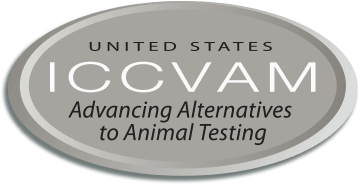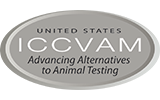Acronyms and Abbreviations
3Rs: principles of replacement, reduction, or refinement of animal use for scientific research or product safety testing
ADME: absorption, distribution, metabolism, and excretion
AOP: adverse outcome pathway
API: application programming interface
ATSDR: Agency for Toxic Substances and Disease Registry
AWIC: Animal Welfare Information Center (U.S. Department of Agriculture)
BraCVAM: Brazilian Center for the Validation of Alternative Methods
CaCVAM: Canadian Centre for the Validation of Alternative Methods
CarciHEI: Carcinogenicity Health Effects Innovation Program (National Institute of Environmental Health Sciences)
CATMoS: Collaborative Acute Toxicity Modeling Suite
CDER: Center for Drug Evaluation and Research (U.S. Food and Drug Administration)
CPSC: U.S. Consumer Product Safety Commission
DNT HEI: Developmental Neurotoxicity Health Effects Innovation Program (National Institute of Environmental Health Sciences)
DNTP: Division of the National Toxicology Program (National Institute of Environmental Health Sciences; renamed "Division of Translational Toxicology" in September 2022)
DoD: U.S. Department of Defense
DOE: U.S. Department of Energy
DOI: U.S. Department of the Interior
DOT: U.S. Department of Transportation
dTP: developmental toxicity potential
ELISA: enzyme-linked immunosorbent assay
ENM: engineered nanomaterials
EPA: U.S. Environmental Protection Agency
EURL ECVAM: European Union Reference Laboratory for Alternatives to Animal Testing
FAIR: findability, accessibility, interoperability, and reusability (of data)
FDA: U.S. Food and Drug Administration
FXR: farnesoid X receptor
GHS: United Nations Globally Harmonized System of Classification and Labeling of Chemicals
HTS: High-throughput screening
httk: High-throughput Toxicokinetics (software package, U.S. Environmental Protection Agency)
IATA: integrated approach to testing and assessment
ICATM: International Cooperation on Alternative Test Methods
ICCVAM: Interagency Coordinating Committee on the Validation of Alternative Methods
ICE: Integrated Chemical Environment (National Toxicology Program)
ICH: International Council for Harmonisation of Technical Requirements for Pharmaceuticals for Human Use
iPSC: induced pluripotent stem cell
IVIVE: in vitro to in vivo extrapolation
JaCVAM: Japanese Center for the Validation of Alternative Methods
KM: half-maximal concentration for metabolism
KoCVAM: Korean Center for the Validation of Alternative Methods
LC50: in traditional acute inhalation or aquatic toxicity tests, the concentration that produces lethality in 50% of the animals tested
LD50: in traditional acute dermal or oral systemic toxicity tests, the dose that produces lethality in 50% of the animals tested
LEL: lowest effect level
LOAEL: lowest observable adverse effect level
MAT: monocyte activation tests
MPS: microphysiological systems
MPSCoRe: MPS for COVID Research working group
NAM: new approach methodology
NASA: National Aeronautics and Space Administration
nAChRs: nicotinic acetylcholine receptors
NC3Rs: National Centre for the Replacement Refinement & Reduction of Animals in Research (United Kingdom)
NCATS: National Center for Advancing Translational Sciences (National Institutes of Health)
NCI: National Cancer Institute (National Institutes of Health)
NICEATM: National Toxicology Program Interagency Center for the Evaluation of Alternative Toxicological Methods
NIEHS: National Institute of Environmental Health Sciences (National Institutes of Health)
NIH: National Institutes of Health
NIOSH: National Institute for Occupational Safety and Health
NIST: National Institute of Standards and Technology
NLM: National Library of Medicine (National Institutes of Health)
NTP: National Toxicology Program
OECD: Organisation for Economic Co-operation and Development
OPERA: Open (Quantitative) Structure-activity/property Relationship App
OSHA: Occupational Safety and Health Administration
PAH: polycyclic aromatic hydrocarbon
PBPK: physiologically based pharmacokinetic
PFAS: per- and polyfluoroalkyl substances
PHMSA: Pipeline and Hazardous Materials Safety Administration (U.S. Department of Transportation)
PK: pharmacokinetic
POD: point of departure
QSAR: quantitative structure-activity relationship
RHDV2: rabbit hemorrhagic disease virus serotype 2
SACATM: Scientific Advisory Committee on Alternative Toxicological Methods
SARA: Skin Allergy Risk Assessment model (Unilever)
SEAZIT: Systematic Evaluation of the Application of Zebrafish in Toxicology (National Toxicology Program)
SOT: Society of Toxicology
ToxCast: Toxicity Forecaster (U.S. Environmental Protection Agency)
ToxRefDB: Toxicity Reference Database (U.S. Environmental Protection Agency)
TSCA: Toxic Substances Control Act (U.S. Environmental Protection Agency)
USDA: U.S. Department of Agriculture
USGS: U.S. Geological Survey (U.S. Department of the Interior)
Vmax: maximal capacity for metabolism



